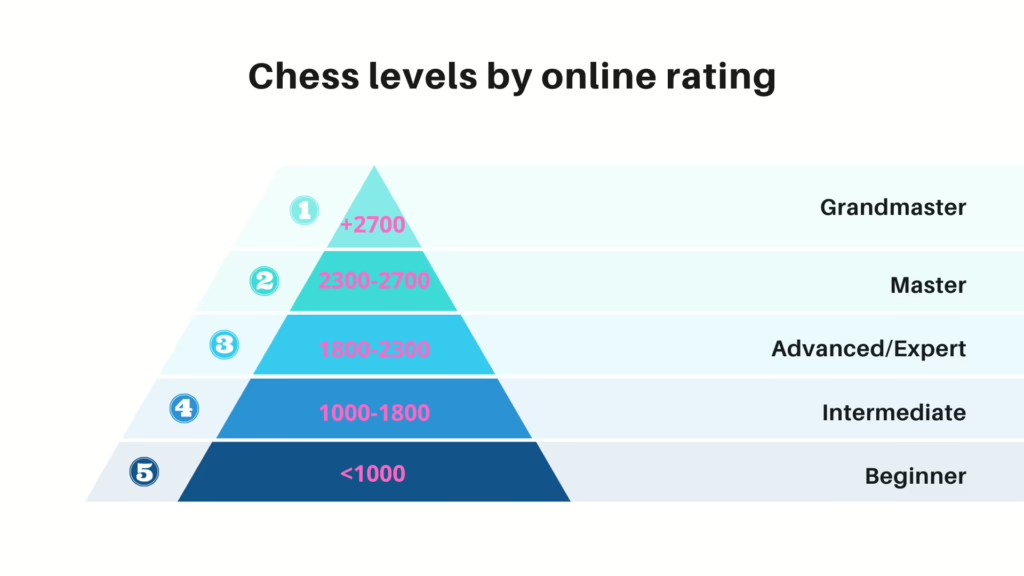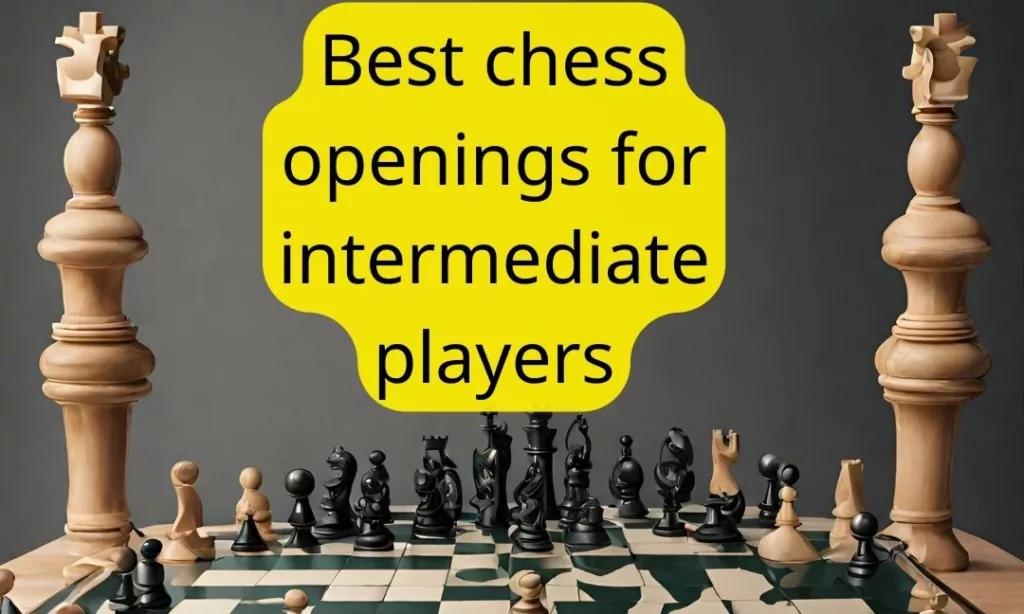This article dives into chess openings, both quiet and aggressive ones, for players who have elo or online rating from 1000 to 1800. It aims to broaden understanding and enhance gameplay.
- I. Introduction
- II. Understanding Intermediate Level in Chess
- III. Criteria for Selecting Openings
- IV. Recommended Openings for Intermediate Players
- V. Unusual Openings for Intermediate Players
- VI. Strategies for Learning and Mastering Openings
- VII. Overcoming Challenges and Pitfalls
- VIII. Advantages and Applications of Mastering Openings
I. Introduction
A. Importance of Openings in Chess
Think of openings as the starting point of a chess journey. They lay down the rules for how the game will unfold, guiding your moves and setting the stage for what’s to come. Openings control the game’s tempo and can shape its entire direction.
“It doesn’t matter how strong a player you are, if you fail to register some development in the opening, then you are asking for trouble.”
English GM John Emms
B. Target Audience: Intermediate Players
If you’re past the basics but not yet a chess wizard, you’re in the intermediate league. For instance, if your ratings on chess.com or lichess fall between around 1000 and 1800, welcome aboard! You’ve got the basics down, but there’s more to explore and learn.
C. Aim of the Article
This article aims to cater specifically to intermediate players by presenting a range of strategic and diverse chess openings. Reading this article, you could broaden your repertoire and elevate your gameplay.
II. Understanding Intermediate Level in Chess
A. Intermediate Player Characteristics
Intermediate players showcase a grasp of fundamental chess concepts like piece development, control of the center, and basic tactics. They start looking at more complex strategies, aiming for long-term advantages rather than immediate gains.
B. Progressions from Beginner to Intermediate
Moving from a beginner to an intermediate level involves a shift in focus, from learning rules and basic tactics to grasping deeper positional ideas, recognizing patterns, and understanding strategic nuances.
C. Expectations and Challenges at this Stage
At the intermediate level, players encounter new challenges such as managing time effectively, refining their strategic thinking, and enhancing tactical awareness. This phase demands a balance between consolidating existing knowledge and exploring more advanced concepts.

III. Criteria for Selecting Openings
A. Emphasizing Flexibility and Versatility
When you’re picking chess openings as an intermediate player, it’s all about staying flexible. Look for openings that offer different ways to play. That way, you can handle all sorts of situations and opponents.
B. Balancing Complexity and Practicality
As an intermediate player, you want openings that are interesting but not too hard. You need them to challenge you, but not so much that they’re confusing during a game.
C. Personal Preferences in Opening Selection
Think about how you like to play. Maybe you’ll do better with certain openings that match your style. When your openings match how you play, it’s more fun and you play better.
For example, if you always play a boring opening like London System, and you want to crank it up a notch or two, try some aggressive ones like the King’s Gambit, Bird’s Opening, Scandinavian Defense or Grob’s Attack, as you will see below.
IV. Recommended Openings for Intermediate Players
As intermediate players seek to expand their repertoire, exploring diverse and strategic openings becomes paramount. Here are four recommended openings that offer rich complexities and tactical opportunities:
A. The Sicilian Defense
The Sicilian Defense stands as a hallmark of dynamic and aggressive play for Black. Among its myriad variations, the Dragon and Najdorf variations stand out for their tactical intricacies and unbalancing potential.
Dragon Variation: Known for its aggressive nature, the Dragon involves Black fianchettoing the g7-bishop and pursuing a kingside pawn storm, often leading to sharp, tactical battles. Understanding thematic pawn breaks and piece activity becomes crucial in mastering this variation. Although, be careful, because Black will have to defend against White’s attack. But there would be many chances for Black to counter attack if White played too fast and careless, like the game below.
Read more: What Makes the Sicilian Defense So Dangerous?
Najdorf Variation: Renowned for its flexibility, the Najdorf offers a blend of solid positional play and attacking possibilities. Its rich theory accommodates various setups, providing players with the chance to tailor their approach based on the game’s demands. Check out the game below to see how White exploits Black’s mistake in the opening.
B. The Queen’s Gambit Declined
The Queen’s Gambit Declined is a classical opening for Black that emphasizes solid, strategic play. Within this opening, exploring key variations like the Tartakower or Orthodox Defense provides intermediate players with a reliable foundation and positional depth.
See more: The Queen’s Gambit Isn’t Just a Netflix Show – It’s a Killer Opening
Tartakower Variation: This variation involves an early …Nf6, aiming for a solid setup. It offers Black a harmonious development while preparing to counterattack White’s central pawn structure. This is one of the most solid setup for Black in openings. Check the game below to see how Black does in Tartakower Defense.
Orthodox Defense: Known for its solidity like Tartakower Variation, the Orthodox Defense focuses on controlling the center and developing pieces harmoniously. Black aims to maintain a compact pawn structure, preparing for potential counterplay later in the game. And White’s aim typically revolves around establishing central control and developing pieces efficiently. White often seeks to exploit the lead in development and initiate strategic plans that can disrupt Black’s harmonious setup, aiming for active piece placement and control over key squares to exert pressure on Black’s position. Let’s see how White could attack Black in Orthodox Defense:
C. The Ruy Lopez
The Ruy Lopez is like a classic treasure chest of chess moves, full of clever plans and different ways to play. If you’re an intermediate player, exploring its versions like the Open Ruy Lopez and the Berlin Defense opens up a whole new world of possibilities.
Open Ruy Lopez: This variation leads to open and dynamic positions, where both sides contend for control of the center. It often results in double-edged play, offering opportunities for tactical fireworks.
Berlin Defense: Known for its solidity and played famously in world championship matches, the Berlin Defense involves an early …Nf6 by Black, often leading to symmetrical pawn structures and strategic maneuvering.
D. The King’s Indian Defense
The King’s Indian Defense is a complex and aggressive opening for Black, offering counterattacking chances while maintaining a solid pawn structure. Exploring the strategic complexities within this opening can be rewarding for intermediate players.
And now, if you still feel these openings boring, it’s time to go through the aggressive ones!
V. Unusual Openings for Intermediate Players
A. Exploring the King’s Gambit
King’s Gambit: A sharp and aggressive opening for White that begins with 1.e4 e5 2.f4. Offering a pawn sacrifice to gain rapid development and open lines for an assault on Black’s king, it leads to dynamic and tactical positions.
Benefits and Challenges: Delve into the dynamics of the King’s Gambit. Explore the benefits of rapid piece activity and initiative while acknowledging the inherent risks of exposing White’s king. Understanding key tactical motifs and counterplay is vital.
Just as the King’s Gambit thrives on bold sacrifices and dynamic play, the Alien Gambit takes risk-taking to a new level, captivating players across the chess world with its unconventional charm and tactical opportunities.
B. The Scandinavian Defense
Scandinavian Defense: Initiated by 1.e4 d5, it allows Black to challenge White’s central pawn immediately. This hypermodern approach aims to disrupt White’s structure and create imbalances from the outset, setting the stage for dynamic middle-game play.
The opening involves Black strategically pushing the d5 pawn to control the center and target White’s e4 pawn. It’s an active choice for Black, despite the unconventional early placement of the queen on d5. White often tries to displace the Black queen to gain an advantage, but Black’s subsequent strategy involves castling queenside, positioning the rook advantageously, and initiating attacks on White’s kingside.
C. The Bird’s Opening
Bird’s Opening: An offbeat choice for White, starting with 1.f4, aims for a quick development of the kingside pieces and the control of the e5 square. The Bird’s Opening often leads to unconventional positions, offering opportunities for creative play.
Unique Possibilities: Investigate the unique possibilities and strategic themes within the Bird’s Opening. Analyze how this approach challenges Black’s typical responses and offers a platform for unorthodox yet principled development. Black can respond with the Dutch variation (1…d5) or From’s Gambit (1…e5). Accepting the gambit intensifies kingside weaknesses, demanding cautious play from White to avoid a swift checkmate. Despite its risks, this opening often appeals to club players, promising a tactical and aggressive game.
D. The Grob’s Attack
The Grob’s Attack is often seen as one of the riskiest moves for White at the start of a chess game. Yet, if White knows some tricks and catches Black off guard, this opening can surprise even skilled players. However, if Black plays well and doesn’t fall for the trap of attacking the g4-pawn too early, they can easily gain a significant advantage. This move by White weakens their kingside and doesn’t help much with piece development, allowing Black to take control of the center and target White’s vulnerable pawn effortlessly.
Moreover, there are numerous chess opening traps that can secure a win in as few as 10 moves or faster. Explore the Fishing Pole Trap, or the Lasker Trap here to learn how it’s done.
VI. Strategies for Learning and Mastering Openings
A. Understanding the Basics
Start by diving into the basics of your chosen openings. Get a hang of the main ideas, like how to place your pieces and what kinds of positions to aim for. Look at games played by the experts and how they handle these openings. It’s like building the foundation of a house, as you want it strong and sturdy.
B. Practice, Practice, Practice
Now it’s time to put what you’ve learned into action. Play lots of games using these openings. You can play online or against friends, just to get comfortable with these strategies. It’s like learning to ride a bike—practice makes perfect!
C. Learn from the Pros
Keep an eye on how the big players handle these openings. Watch videos or read books that explain how the experts do it. This is like having a coach showing you all the tricks. They’ve been there and done that!
VII. Overcoming Challenges and Pitfalls
A. Addressing Common Difficulties
Sometimes, things get tough. You might find it hard to remember all the moves or deal with tricky situations. That’s normal! Acknowledge these difficulties—they’re the bumps in the road you can learn to navigate.
B. Strategies for Tackling Obstacles
Here’s the trick: tackle problems step by step. Review what you’ve learned, solve puzzles related to these openings, and ask for help when you need it. Practice regularly and stay determined. It’s like solving a puzzle, piece by piece.
C. Embracing Patience and Adaptability
Remember, mastering chess takes time. Be patient with yourself and keep at it. Change your approach if needed, learn from your experiences, and stay open to growing. Think of it like planting a garden. You need patience to see the flowers bloom!
VIII. Advantages and Applications of Mastering Openings
A. The Benefits of Expertise in Specific Openings
Becoming a pro at specific openings gives you a head start. You’ll know what to expect, which helps you plan better for the middle and endgame. It’s like having a map, guiding you through the game.
B. Impact on Overall Gameplay
When you’re good at openings, you’ll feel more confident in your decisions. This helps you think faster and make better moves when it matters most. It’s like having a secret weapon. It gives you an edge.
C. Strategic Edge and Tactical Understanding
Mastering openings gives you an advantage. You can predict what your opponent might do and find opportunities to strike. Plus, it helps you understand chess better overall. It’s like being one step ahead in a game of chess.
It isn’t just about learning moves; it’s about understanding strategies, practicing consistently, and growing as a player. Embrace the challenges, seek guidance, and keep at it. Those openings hold the key to your strategic growth as an intermediate player.

I’m Xuan Binh, the founder of Attacking Chess, and the Deputy Head of Communications at the Vietnam Chess Federation (VCF). My chess.com and lichess rating is above 2300. Send me a challenge or message via Lichess. Follow me on Twitter (X) or Facebook.


4 thoughts on “Chess Openings for Intermediate Players (Ratings from 1000 to 1800)”
Comments are closed.